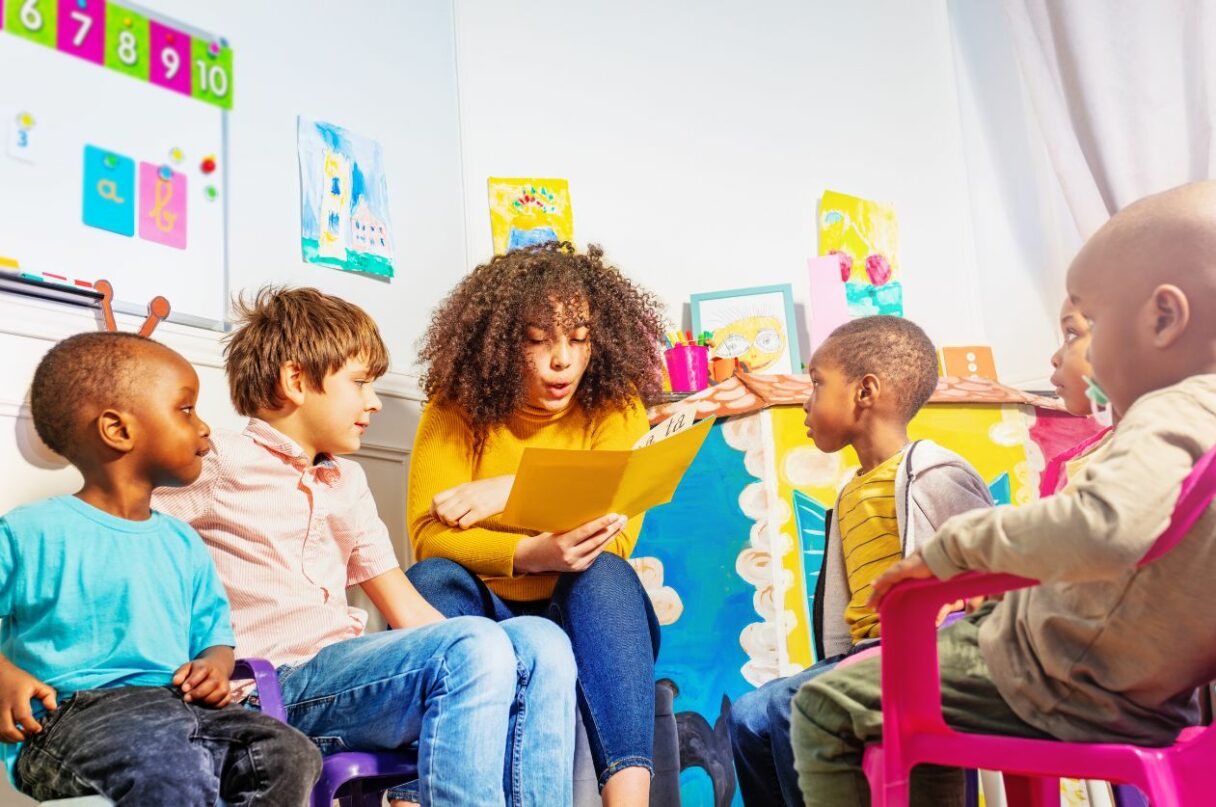Introduction
To understand interactive fiction it is essential to grasp the definitions of both ‘interactive’ and ‘fiction’. The word interactive describes the communication and middle point between when a person either connects with or influences a living being or an innate object, in education this is often associated between a reader and a book.
It applies to a range of scenarios such as digital devices however too, not just books. Interactivity focuses on engagement, involvement, and input through action(s). Synonyms for interactive can include: bilateral, collective, reciprocal, associated, communal, and connected.
Fiction is a type of literature or storyline that is invented, it is based upon imagination and creativity. Although it can be inspired by real facts, people, and places it ultimately is made up. Through fantasy important moral lessons can be taught that students can apply to their own lives.
Often fiction can be used as a device to help an audience or reader forget what is happening in their own life as they are immersed in the characters’ lives. This consumption can be purely for enjoyment or used as an aid for distraction.
Interactive fiction explained and how it differentiates from “regular” fiction

The highlight of interactive storytelling is allowing readers the chance to gain some control of the narrative. This is accomplished in various ways, more often through giving readers the choice to have different endings in their stories but also by the chance to name characters, answer prompt quizzes, etc.
This shouldn’t be confused with allowing the readers to have entirely free reign with the story otherwise they could simply write their own. It focuses on incorporating the readers into shaping the narrative, offering options and choices to answer and respond to the story, allowing it to continue but on a slightly different path.
Each student reading the book has the chance to experience it through their eyes differently. Interactive fiction can be presented in a range of formats aside from books, for example online or board games, comics, and TV shows.
It often has the recurring theme of an adventure or mystery too in which the player or reader is given choices as to how the storyline is to develop or the mystery/problem is solved.
One popular example of interactive fiction you might be familiar with is a particular episode The Bandersnatch from the highly successful Netflix series Black Mirror, known for challenging morals, technology, and modern-day ideas. This particular episode follows the interactive fiction adventure game challenged with problems to overcome and decisions to make with five possible endings.
Benefits of interactive fiction for students
By giving the power and freedom of choice to students i.e. the audience and readers, interactive fiction promotes both imagination and thinking outside of the box.
Interactive fiction is a broad method not limited to any one type of education. For example, it can be utilized to learn a foreign language i.e. through writing a new narrative or quizzes about the text. Engaging the reader more helps them to grasp the understanding of the text better, learn vocabulary, and think about how they can rewrite what they’ve read differently.
Nurtures the students to become more inquisitive and logical thinkers. Improve competency in basic literacy skills, upon their ICT tools for digital writing, comprehension, and reading fluency.
Not only can interactive fiction help in the academic sense through whichever subject is being taught but arguably more importantly it can subtly teach about attitudes, values, and knowledge. Developing the building blocks of their cognitive mindset along with critical, systematic, and creative thinking along with emotional and social skills.
In a day and age where cognitive thinking is less and less activated as a result of information always being widely accessible at the click of a button for example with AI and search engines like Google, many students can find answers and study without stimulating these parts of their brain. The problem with this is students stop thinking for themselves.
Unlike other types of leisure which can often be deemed as ‘lazy’ or non-educational, it stimulates the brain more than any other media/book/game.
Enables students who are perhaps more shy, anxious, or less confident to engage and participate in the lesson and work in a way that’s different for example than putting up their hand and answering verbally.
Problem-solving, decision-making, risk-taking, memory exercises, and learning to lose through options such as ‘ending not possible ‘, ‘choose again’, or a disappointing ending, along with peer assessment amongst students subtly strengthens resilience and patience. All real-life skills to prepare them for when they leave the classroom and on to new chapters of their lives.
Interactive fiction: an aid for teachers

Interactive fiction can help build upon teacher competency and fulfillment by allowing for a more personalized and extremely customizable learning experience for students as well as something new and stimulating for teachers to try.
Adding variety to teaching through the addition of new and different tasks is crucial to promote progress, stimulation, and enjoyment in lessons for teachers and students.
Doing something unfamiliar generates new neural pathways in the brain and therefore holds attention for longer as it is new and exciting and will become more memorable. This is beneficial to help encourage reluctant learners and readers to get involved and as a result, will have a positive impact and association with the teacher.
Interactive fiction provides the ability to present and build upon two things simultaneously hand in hand in a single activity killing two birds with one stone, for example, to teach about a specific topic about European culture whilst also improving on grammar in a class, ensuring a more efficient and productive lesson.
Different learning styles

Visual, Auditory, Kinesthetic, Read/write Within each learning style, different approaches are better complimented for each individual. Visual learners learn best through a combination of ideas and information presented through videos, graphs, diagrams, maps, patterns, and shapes as opposed to spoken or written words.
Whereas kinesthetic prefer more hands-on lessons such as physical activities like experiments and auditory learners thrive best through podcast discussions, music, and voice recording tasks. Many studies have demonstrated how using multimodal styles reaches a higher percentage of students no matter their preconceived preference or ability.
To encourage and support students of diverse backgrounds and interests enabling more students to flourish it is essential to aim to create a more tailored and inclusive class for everyone.
Allowing for a more diverse range of teaching methods and materials to be utilized to ensure both student satisfaction and progress are met along with teaching competency.
Therefore if teachers are always using the same monotonous methods with no diversity in their teaching it can become aimed at a certain type of learner.
Being aware of different learning requirements such as different stimuli for your class ensures that everybody does well, targeting all learning styles and allowing for optimum comprehension.
Numerous evidence-based studies have also shown that active engagement outperforms passive learning along with extensive research done supporting the importance of a varied education, with the majority of humans being multimodal learners meaning they learn best through not one of the 4 learning styles but a combination of them all.
In our day and age with the access to this knowledge we didn’t have prior it is quintessential to now convey it in our teachings to gain more efficiency and productivity.
How to create interactive fiction
To demonstrate an example for the article, below is a basic step-by-step guide on how to invent your own written interactive adventure short story. Here are just some simple instructions to get you started.
1. Think of an Idea
- Firstly set yourself a time limit of an hour. It is supposed to be a short story! This should roughly be 8-12 paragraphs. Pen and paper? Or the help of a digital tool?-Twine is highly recommended if you choose to opt for this.
- Set out a specific intention or goal for your interactive story, what do you want to achieve with it? A specific learning outcome? A particular topic? Will it be in a foreign language? Or have the addition of new vocabulary?
- Jot down the main idea for the plot. Important aspects to consider when writing any story are location, task, and main character. The longest storyline must include a beginning, a challenge/ key event in the middle, and a conclusion when the challenge is tied up and overcome.
- Remember for your interactive short story to work there must be at least 2 key moments when the protagonist has to make an important choice so start to consider options, here you will create your sub-stories and options where the reader will get to make their own decision.
- Think about alternative endings and paths that will affect the protagonist. This will serve as your other story options, depending on what the reader will pick in your adventure. This will help you later on creating a structure for the adventure.

2. Shape the structure of your story
- Identify when in your story you will give the reader significant decisions to make that will modify the course of the plot and how they then will go on to affect the story ending.
- Think about the type of choice you want to present to your reader. Will it be tactical? Strategical? Moral and ethical? Blind choice? Will it require the reader to solve a riddle? A puzzle? A short quiz?
- Each choice for the reader should start with: What would you like to do? The following chosen option will start with: You chose to do ‘X’. For example, you offer the choice between swimming in the sea or flying on the back of a dragon’s back to reach your destination. You chose to swim in the ocean.
3. Shape the branching of your story
With each option and choice decide whether the story will end negatively i.e. failing to be able to continue or positively with an alternate ending or being merged into a written plot. After the introduction, each next step of the story will have a subsection for the alternate option. I.e. written as options 1.1 and 1.2 below.
- Introduction, with your first choice leading to two answers.
- Option 1.1, Successful outcome leading to another two options.
- Option 1.2, Outcome failure, this could be in the form of the story ending quickly or something bad happening to the character or plot. The story cannot continue any further.
- Option 2.1, Successful outcome that will lead to more options allowing the story to continue.
- Option 2.2, outcome failure.
- Option 3.1 This will lead to your conclusion.
- Option 3.2, through an alternative way you will also end up at the conclusion.
- Conclusion/ending.
4. Start to write your adventure gamebook sections
Now you have a clear idea of how you can organize your storyline, you can begin to write each section. Whilst writing each section make clear the beginning and ending of your section, you can also introduce hints as to whether your character is making good progress or they are going downhill.
Ensure to add lots of detail and try your best to build up the climax to the main event/task of your plot.
5. Finalise the design
For your reader to follow the correct order of the layout of your story and not accidentally read both options or go ahead, you will need to mark each section; this can be done in many ways such as drawings, arrows, or numbers.
Assemble your story, put your pages together, give your book a cover, and include illustrations if desired. Now have fun experimenting and testing out what works with your story, this can be through feedback from others until you are satisfied with your final version of your very own interactive fiction!
Tips for teachers to guide their pupils

To conclude, there is no one way to teach interactive fiction which is why it is so great. It can be designed for individual students or teamwork, implemented in the classroom or with flipped learning, and also used as a positive combination between reading and playing for the younger ones.
You can use either pre-written fiction or your own. Remember as educators the goal is to create a welcoming, positive, and stimulating learning environment for pupils, therefore the most important key for interactive fiction to work is open-mindedness.
Whichever unique path your student decides to take with their ideas, go with it and make sure everybody is learning and having fun!

One way to teach interactive fiction which is why it is so great. It can be designed for individual students or teamwork, implemented in the classroom or with flipped learning, and also used as a positive combination between reading and playing for the younger ones. You can use either pre-written fiction or your own. Remember as educators the goal is to create a welcoming, positive, and stimulating learning environment for pupils, therefore the most important key for interactive fiction to work is open-mindedness.